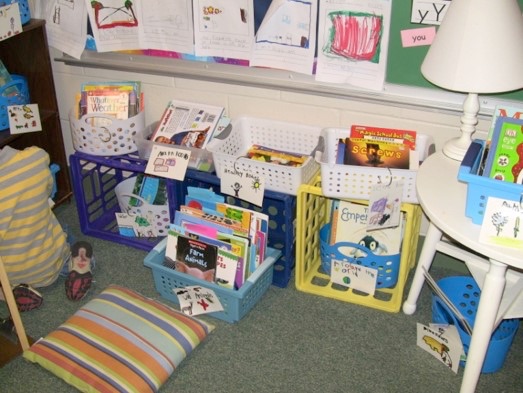Chapter 3: Finding The Balance: Pairing NonFiction and Realistic Fiction
3.4 Books -A Compass On My Journey
Throughout all the changes, though, I remained a teacher who loves children’s literature. I don’t own expensive jewelry or handbags. My joy comes from browsing the shelves at bookstores, reading blogs about the newest and best books out there, and adding titles to my electronic shopping cart. I am giddy when I notice the familiar smiling box on my doorstep holding the next jewel for my collection. Throughout my career, I chose to buy books – lovely, engaging books. I was proud of the collection I had to offer my students; twenty four large red plastic baskets lined the shelves under the classroom windows. Each basket held fifteen or more picture books grouped by genre (biographies, realistic fiction, fantasy, traditional literature, poetry, information) or by topic (sports, animals, school, jokes and riddles, songs). Chapter books filled the remaining shelves placed about the room. Books were displayed on windowsills, chalk ledges, and propped against the walls. In spite of the ever-changing mandates, standards, and a long list of alphabet-soup acronyms, I continued to place children’s literature at the center of my planning for the learners in my classroom.
While selecting children’s books for my planning, I watched as my colleagues dove into the nonfiction genre with great vigor. They planned rich and engaging units that focused on nonfiction reading and writing. The literature blogs, professional development sessions, and journal articles were full of nonfiction titles and authors. I created a new wish list of mentor texts. I loved these shiny gems and my electronic shopping cart overflowed once again. I embraced the nonfiction genre enthusiastically, but did not want to give up the wonderful stories that were an integral part of my teaching, my passion, and that helped foster a sense of community and curiosity in my classroom. And then one day, as I was organizing my classroom library, I stopped in my tracks as I straightened a basket of beginning chapter books. There in front of me sat my inspiration. Will and Mary Pope Osborne gave me the answer I was searching for. I could share paired texts – fiction and nonfiction – in much the same way these authors paired the Magic Tree House stories and the Magic Tree House Fact Trackers. The time travel adventure series featuring brother and sister, Jack and Annie, were favorites in my classroom and students often turned to the fact tracker to discover more information and answer the questions they generated before, during and after reading the story.
My next task, then, was finding the balance as I paired fiction with nonfiction. I was not intimidated or overwhelmed by this task of pairing books since I was already accustomed to using both fiction and nonfiction books in my planning. Now, however, it was time to think more carefully about this endeavor. I created text sets based on my belief that these pairings were important. Using paired books for read alouds, mentor texts, and content learning would support the new national standards for English Language Arts as well as state standards for Science and Social Studies. The pairings would excite my students, help them develop background knowledge, and increase their vocabularies. I would draw my students in through the fictional story and deepen their understandings with a nonfiction text on the same topic. Doing so would also offer my students a window into experiences they had not lived. They would be introduced to new perspectives and scientific learning anchored in the realistic fiction I planned to share.
As I began pairing books, I looked for other real-world examples to share with students. My school media specialist, as she often did, came to my rescue. She introduced my class to the subscription website BookFlix. Scholastic BookFlix pairs classic video storybooks with related nonfiction eBooks. The site is organized by content area topics such as Earth and Sky. One such example of a pairing is Miss Rumphius and From Seed to Dandelion. This website quickly became the centerpiece of my classroom listening center. Children eagerly awaited their weekly turn to “Listen to Books” as part of our morning reading workshop. I regularly overheard students in the computer corner whispering about some new topic or piece of information they encountered while on the BookFlix site. Often their excitement grew and spilled over into the otherwise quiet classroom. Undoubtedly, the book pairings were delightful, engaging, and interesting to my second graders. The BookFlix site quickly became another model of paired books.
